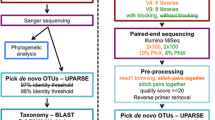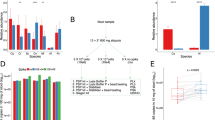Abstract
The main aim of this study was to evaluate the specificity of three commonly used 16S rRNA gene-based polymerase chain reaction (PCR) primer sets for bacterial community analysis of samples contaminated with eukaryotic DNA. The specificity of primer sets targeting the V3, V3-V5, and V6-V8 hypervariable regions of the 16S rRNA gene was investigated in silico and by community fingerprinting of human and fish intestinal samples. Both in silico and PCR-based analysis revealed cross-reactivity of the V3 and V3-V5 primers with the 18S rRNA gene of human and sturgeon. The consequences of this primer anomaly were illustrated by denaturing gradient gel electrophoresis (DGGE) profiling of microbial communities in human feces and mixed gut of Siberian sturgeon. DGGE profiling indicated that the cross-reactivity of 16S rRNA gene primers with nontarget eukaryotic DNA might lead to an overestimation of bacterial biodiversity. This study has confirmed previous sporadic indications in literature indicating that several commonly applied 16S rRNA gene primer sets lack specificity toward bacteria in the presence of eukaryotic DNA. The phenomenon of cross-reactivity is a potential source of systematic error in all biodiversity studies where no subsequent analysis of individual community amplicons by cloning and sequencing is performed.


Similar content being viewed by others
References
Amann RI, Ludwig W (2000) Ribosomal RNA-targeted nucleic acid probes for studies in microbial ecology. FEMS Microb Rev 24:555–565
Amann RI, Ludwig W, Schleifer KH (1995) Phylogenetic identification and in-situ detection of individual microbial cells without cultivation. Microbiol Rev 59:143–169
Ampe F, Ben Omar N, Moizan C et al (1999) Polyphasic study of the spatial distribution of micro-organisms in Mexican pozol, a maize-fermented dough, demonstrates the need for cultivation-independent methods to investigate traditional fermentations. Appl Environ Microbiol 65:5464–5473
Ampe F, Miambi E (2000) Cluster analysis, richness and biodiversity indexes derived from denaturing gradient gel electrophoresis fingerprints of bacterial communities demonstrate that traditional maize fermentations are driven by the transformation process. Int J Food Microbiol 60:91–97
Casellas F, Antolin M, Varela F et al (2004) Fecal excretion of human deoxyribonucleic acid as an index of inflammatory activity in ulcerative colitis. Clin Gastroenterol Hepatol 2:683–689
Cole JR, Chai B, Farris RJ et al (2005) The Ribosomal Database Project (RDP-II): sequences and tools for high-throughput rRNA analysis. Nucleic Acids Res 33:D294–D296
Crosby LD, Criddle CS (2003) Understanding bias in microbial community analysis techniques due to RRN operon copy number heterogeneity. Biotechnology 34:790–798
Dahllöf I, Baillie H, Kjelleberg S (2000) rpoB-Based microbial community analysis avoids limitations inherent in 16S rRNA gene intraspecies heterogeneity. Appl Environ Microbiol 66:3376–3380
De Angelis M, Di Cagno R, Gallo G et al (2007) Molecular and functional characterization of Lactobacillus sanfranciscensis strains isolated from sourdoughs. Int J Food Microbiol 114:69–82
Fogel GB, Collins C R, Li J, Brunk CF (1999) Prokaryotic genome size and SSU rDNA copy number: estimation of microbial relative abundance from a mixed population. Microb Ecol 38:93–113
Miller SA, Dykes DD, Polesky HF (1988) A simple salting out procedure for extracting DNA from human nucleated cells. Nucleic Acids Res 16:1215
Muyzer G, Dewaal EC, Uitterlinden AG (1993) Profiling of complex microbial-populations by denaturing gradient gel-electrophoresis analysis of polymerase chain reaction-amplified genes-coding for 16S ribosomal-RNA. Appl Environ Microbiol 59:695–700
Muyzer G, Hottenträger S, Teske A, Wawer C (1995) Denaturing gradient gel electrophoresis of PCR-amplified 16S rDNA-a new molecular approach to analyse the genetic diversity of mixed microbial communities. In: Akkermans ADL, van Elsas JD, de Bruijn FJ (eds) Molecular microbial ecology manual, 2nd ed. Kluwer, Dordrecht, pp 3.4.4.1–3.4.4.22
Muyzer G, Hottenträger S, Teske A, Wawer C (1996) Denaturing gradient gel electrophoresis of PCR-amplified 16S rDNA: a new molecular approach to analyze the genetic diversity of mixed microbial communities. Mol Microb Ecol Manual 3.4.4:1–23
Nübel U, Engelen B, Fleske A et al (1996) Sequence heterogeneities of genes encoding 16S rRNAs in Paenibacillus polymyxa detected by temperature gradient gel electrophoresis. J Bacteriol 178:5636–5643
Pitcher DG, Saunders NA, Owen RJ (1989) Rapid extraction of bacterial genomic DNA with guanidium thiocyanate. Lett Appl Microbiol 8:151–156
Rantsiou K, Comi G, Cocolin L (2004) The rpoB gene as a target for PCR-DGGE analysis to follow lactic acid bacterial population dynamics during food fermentation. Food Microbiol 21:481–487
Renouf V, Claisse O, Miot-Sertier C, Lonvaud-Funel A (2006) Lactic acid bacteria evolution during winemaking: use of rpoB gene as a target for PCR-DGGE analysis. Food Microbiol 23:136–145
Rivas R, Velázquez E, Zurdo-Piñeiro JL et al (2004) Identification of microorganisms by PCR amplification and sequencing of a universal amplified ribosomal region present in both prokaryotes and eukaryotes. J Microbiol Methods 56:413–426
Sipos R, Székely A J, Palatinszky M et al (2007) Effect of primer mismatch, annealing temperature and PCR cycle number on 16S rRNA gene-targetting bacterial community analysis. FEMS Microbiol Ecol 60:341–350
Smalla K, Oros-Sichler M, Milling A et al (2007) Bacterial diversity of soils assessed by DGGE, T-RFLP and SSCP fingerprints of PCR-amplified 16S rRNA gene fragments: Do the different methods provide similar results? J Microbiol Methods 69:470–479
Vanhoutte T, Huys G, De Brandt E, Swings J (2004) Temporal stability analysis of the microbiota in human feces by denaturating gradient gel electrophoresis using universal and group-specific 16S rRNA gene primers. FEMS Microbiol Ecol 48:437–446
Vanhoutte T, Huys G, De Brandt E et al (2005) Molecular monitoring and characterization of the faecal microbiota of healthy dogs during fructan supplementation. FEMS Microbiol Lett 249:65–71
Woese CR (1987) Bacterial evolution. Microbiol Rev 51:221–271
Acknowledgment
This work was supported by IWT-Vlaanderen, Brussels, Belgium (GBOU project No. 010054). G.H. is a postdoctoral fellow of the Fund for Scientific Research-Flanders (F.W.O.-Vlaanderen, Belgium).
Author information
Authors and Affiliations
Corresponding author
Rights and permissions
About this article
Cite this article
Huys, G., Vanhoutte, T., Joossens, M. et al. Coamplification of Eukaryotic DNA with 16S rRNA Gene-Based PCR Primers: Possible Consequences for Population Fingerprinting of Complex Microbial Communities. Curr Microbiol 56, 553–557 (2008). https://doi.org/10.1007/s00284-008-9122-z
Received:
Accepted:
Published:
Issue Date:
DOI: https://doi.org/10.1007/s00284-008-9122-z




